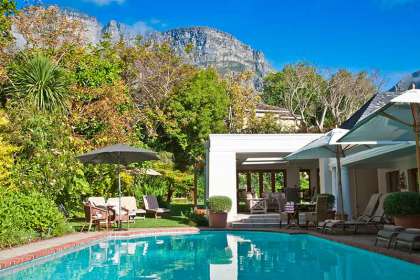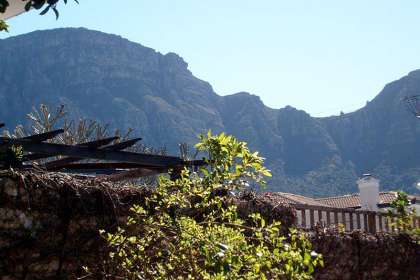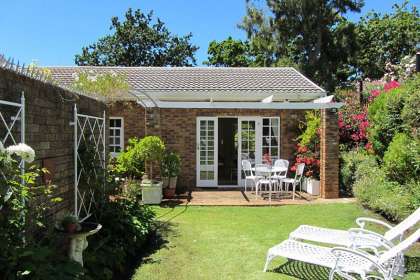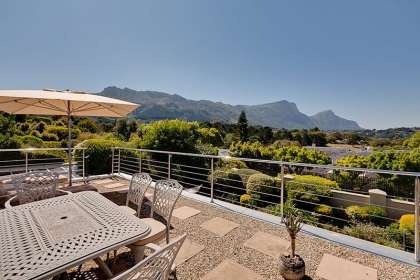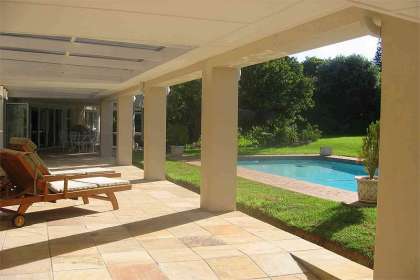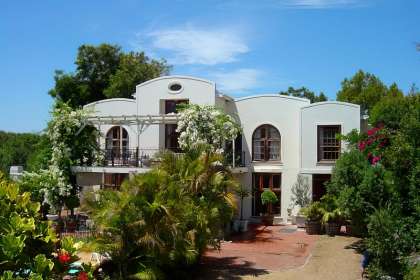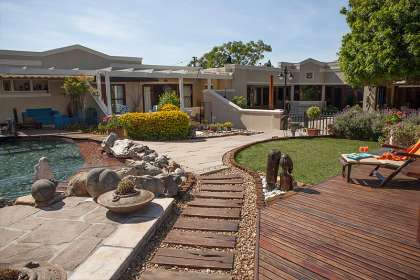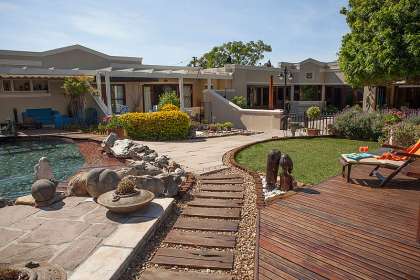Kirstenbosch National Botanical Gardens
Kirstenbosch National Botanical Gardens
The Kirstenbosch National Botanical Gardens began with the creation of a hedgerow of wild almond known as the van Riebeeck's hedge, which was planted as a border to keep the cattle where they belonged. Cecil Rhodes purchased the land in 1895 and planted a wonderful collection of camphor trees on what is now called Camphor Ave. When he died, the property was given to the City and has gradually grown into the world-class botanical garden that we see today.
Main attractions:
The Protea Garden boasts the world's best collection of proteas. It is best visited during the cooler wet months between June and October when these plants are flowering.
The Restio Garden has a wonderful display of these grassy reed-like members of fynbos.
A Water-Wise Garden educates gardeners in water conservation and the techniques that can be applied to their home garden.
The Peninsula Garden specialises in floral species characteristic of the unique habitat of the Cape Peninsula.
The Medicinal Garden explains the curious medicinal values of South African herbs and other plants.
The Fragrance Garden is a treat for the blind where plants with special textures and scents can be appreciated and provides an interesting test of your olfactory acuity.
The Kirstenbosch Garden Fair is an annual event that takes place every March just outside the front gates where the public may purchase plants.
10 interesting facts about the Kirstenbosch National Botanical Gardens in Cape Town:
1. World Heritage Site: Kirstenbosch is part of the Cape Floristic Region, a UNESCO World Heritage Site, recognized for its rich biodiversity and unique plant life.
2. Indigenous Flora: The garden exclusively cultivates indigenous South African plants, showcasing over 7,000 species, including many rare and endangered ones.
3. Centennial Garden: Established in 1913, Kirstenbosch was the first botanical garden in the world dedicated to indigenous flora, celebrating over a century of botanical preservation.
4. Boomslang Walkway: The Centenary Tree Canopy Walkway, known as the "Boomslang" (tree snake), is a curved, elevated walkway that offers panoramic views of the garden and the surrounding mountains.
5. Medicinal Plants: The Useful Plants Garden section displays plants used for traditional medicine, food, and other practical applications, highlighting the cultural importance of South Africa's flora.
6. Protea Garden: Kirstenbosch features a stunning collection of proteas, including the King Protea, South Africa's national flower, which blooms with large, striking flowers.
7. Fynbos Showcase: The garden is renowned for its extensive collection of fynbos, the unique shrubland vegetation found only in the Cape Floristic Region.
8. Biodiversity Research: Kirstenbosch is a center for botanical research and conservation, with ongoing projects to study and protect South Africa's diverse plant life.
9. Summer Concerts: The garden hosts popular open-air summer concerts on its expansive lawns, featuring local and international musicians in a beautiful natural setting.
10. Camphor Avenue: A picturesque avenue lined with ancient camphor trees, planted in the late 1800s by Cecil Rhodes, provides a tranquil and historic walkway within the garden.
Accommodation Near Kirstenbosch National Botanical Gardens
Fernwood Manor
Bed & Breakfast Accommodation in Newlands, Cape Town
1.7km from Kirstenbosch National Botanical GardensFernwood Manor is an elegant colonial style home in the leafy suburb of Newlands surrounded by lush greenery with wonderful mountain views. Our exclusive guest house, catering for no more than 16 guests, ensures warm friendly personal service... …see more for bookings / enquiries and info.
Glencoy
Self Catering Apartment, Flatlet Accommodation in Claremont
2.6km from Kirstenbosch National Botanical GardensGlencoy provides self catering accommodation in Claremont, Cape Town. Glencoy is an upmarket, private self-catering apartment and en-suite guest room. It is situated in the quiet residential area of Upper Claremont. With a striking view of Table Mountain. …see more for bookings / enquiries and info.
Bel Ombre Cottages
Self Catering House, Cottage, Chalet Accommodation in Constantia, Cape Town
2.7km from Kirstenbosch National Botanical GardensBel Ombre Cottages provide self catering cottage accommodation in Constantia, Cape Town. Bel Ombre Cottages are luxuriously furnished and fully equipped self catering cottages in the beautiful Constantia Valley, the ideal base from which to explore... …see more for bookings / enquiries and info.
Le Bonheur Villas and Cottages
Self Catering Apartment, Flatlet Accommodation in Constantia, Cape Town
3.1km from Kirstenbosch National Botanical GardensLe Bonheur Villa and Cottages offers a selection of self catering accommodation in Constantia, Cape Town. 4 self catering options are available: Villa - 6 bedrooms that sleeps 12, 4 bathrooms (3 en-suite). Protected from the summer winds... …see more for bookings / enquiries and info.
Valley Heights B&B / Guest House
Self Catering Apartment, Flatlet Accommodation in Kenilworth
3.5km from Kirstenbosch National Botanical GardensValley Heights Guest House provides bed and breakfast and self catering accommodation in Kenilworth, Cape Town. Situated in the peaceful, safe and leafy suburb of Upper Kenilworth in Cape Town's Southern Suburbs and has easy access to major tourist... …see more for bookings / enquiries and info.
Pepper Hollow
Self Catering Apartment, Flatlet Accommodation in Constantia, Cape Town
3.6km from Kirstenbosch National Botanical GardensPepper Hollow offers self catering cottage accommodation in Constantia, Cape Town. The accommodation consists of one self-catering cottage with 2 bedrooms. The main bedroom has a queen size bed & dressing table with an en-suite bathroom. …see more for bookings / enquiries and info.
Hidden Way
Self Catering Apartment, Flatlet Accommodation in Constantia, Cape Town
4.2km from Kirstenbosch National Botanical GardensHidden Way provides self catering flatlet accommodation in Constantia, Cape Town. Hidden Way is situated in a quiet pan-handle with secure, covered off-street parking and a private patio. The flatlet is self-catering and has a separate fully-equipped kitc …see more for bookings / enquiries and info.
At Villa Fig Guest House
Self Catering Apartment, Flatlet Accommodation in Constantia, Cape Town
4.4km from Kirstenbosch National Botanical GardensHoliday or business, bed and breakfast or self catering... come to At Villa Fig Guest House, situated in the tranquil Constantia Valley and enjoy the mountain views from your bedroom and balcony. …see more for bookings / enquiries and info.
Kaya La Provence Self Catering Cottage
Self Catering House, Cottage, Chalet Accommodation in Plumstead
4.5km from Kirstenbosch National Botanical GardensKaya La Provence provides self catering accommodation in Plumstead, Cape Town. Situated in a secure and safe neighbourhood on the border of Constantia and Plumstead, Kaya La Provence offers a warm and relaxed atmosphere with a beautiful Self Catering... …see more for bookings / enquiries and info.
Kaya La Provence
Bed & Breakfast Accommodation in Plumstead
4.5km from Kirstenbosch National Botanical GardensSituated in a secure and safe neighbourhood on the border of Constantia and Plumstead, Kaya La Provence offers a warm and relaxed atmosphere with two B&B Suites in the Manor House. Experience outdoor living with a communal swimming pool, outdoor Jacuzzi. …see more for bookings / enquiries and info.
- Kirstenbosch Biennale (0.45km)
- The Van Riebeeck Hedge (0.45km)
- Skeleton Gorge Hikes (0.45km)
- Honey and Hounds Woman's Brunch (0.49km)
- Big Bottle Food and Wine Festival (1.77km)
- Maclears Beacon (1.90km)
- Constantia Gift Fair (2.45km)
- Burgundy Lovers festival - Cape Town (2.85km)
- Cavendish Square Charity Book Sale (3.28km)
- Cavendish Square Bridal Exhibition (3.28km)
- Cavendish Square (3.29km)
- Devil's Peak (3.34km)
- Alphen Hotel (3.42km)
- Old Mutual Two Oceans Marathon (3.68km)
- Oktober Bierfest Cape Town (3.69km)
- Table Mountain Guided Hike (3.75km)
- Cape Horticultural Societys Flower and Garden Show (3.77km)
- Table Mountain National Park (3.78km)
- Kingsbury Hospital (3.84km)
- Josephine Mill (3.85km)





